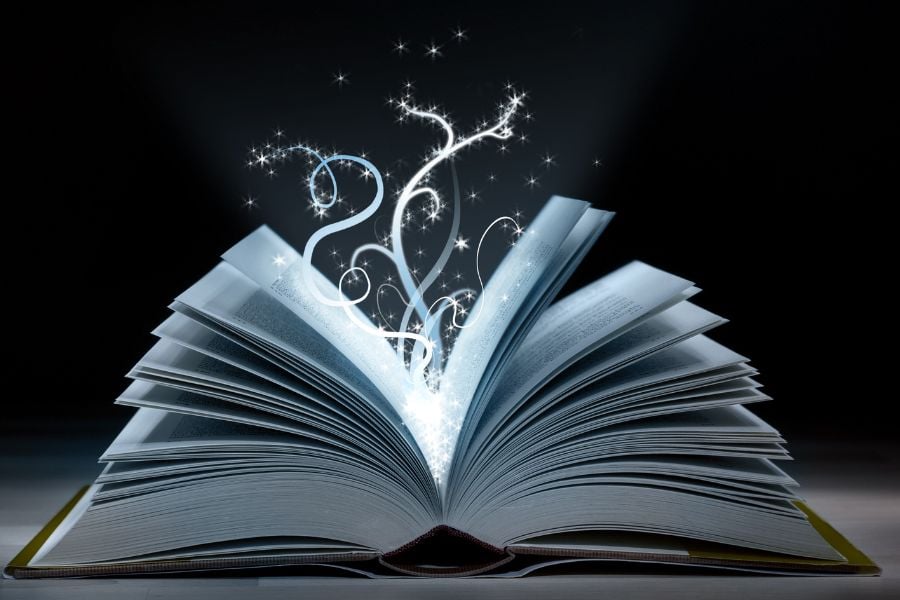The Hero’s Journey is everywhere.
From ancient myths to modern cinema, it’s a story blueprint that’s stood the test of time. Why?
Because it echoes our lives.
As humans, we all face challenges, grow, and transform. So stories featuring characters that face challenges and grow as we do resonate with us.
And this transformation process is precisely what the Hero’s Journey is all about.
Our post delves into the knicks and crannies of this narrative framework to not only enhances our appreciation of stories but also shed light on our own adventures.
Ready?
Let’s jump in!

What is the Hero’s Journey?
The Hero’s Journey, introduced by mythologist Joseph Campbell in his book, Hero With a Thousand Faces, is a universal storytelling pattern found across cultures and eras.
This literary tool follows a hero through specific stages, starting from their familiar world, leading them through challenges and adventures, and culminating in their transformational return.
Integral to this journey are key characters like the guiding mentor, the loyal sidekick, and the unpredictable trickster.
This age-old template resonates with audiences because it reflects personal trials and growth, making it a fundamental component in captivating stories.
Dissecting the 12 Fundamental Steps of the Hero’s Journey
Let’s delve into each stage of the Hero’s Journey to understand their significance, with examples and tips for executing each step in your own writing.
Step 1: The Ordinary World
Every tale begins in the hero’s regular life before adventure ensues. Consider Luke Skywalker on Tatooine’s moisture farm. His ordinary world is familiar and mundane.
As a writer, learn to ground your character in relatable routines to accentuate the contrast when the adventure begins.
Step 2: Call to Adventure
This pivotal moment disrupts the hero’s routine, propelling them toward an unknown journey. Like when Bilbo Baggins receives an unexpected invitation in The Hobbit.
When crafting your own call to adventure, ensure the call is irresistible and disrupts the hero’s status quo, even if it’s subtle.
Step 3: Refusal of the Call
Doubt often clouds the hero’s judgment, making them hesitant to act. Like Rick Blaine in Casablanca, conflicted by his past with Ilsa.
In your own stories, use this hesitation to highlight the hero’s vulnerabilities, making them more relatable.
Step 4: Meeting the Mentor

Every hero needs someone who offers wisdom, tools, or both. In The Matrix, Neo finds Morpheus, who reveals the truth to Neo and provides the skills Neo needs.
Remember: Mentors should challenge and deepen the hero’s journey, but they might not have all the answers.
Step 5: Crossing the Threshold
Here, the hero fully commits to the adventure. Dorothy, in The Wizard of Oz experiences this when she’s whisked into the world of Oz.
When writing, keep in mind that this transition should feel transformative. Emphasize this change to signify that there’s no turning back for the hero.
Step 6: Tests, Allies, Enemies
Heroes must face challenges, forge alliances, and identify adversaries. In The Fellowship of the Ring, Frodo meets allies like Legolas and Gimli and fights enemies like the Ringwraiths.
Quick tip for writers: Include varied challenges and characters that reflect or challenge the hero’s beliefs.
Step 7: Approach to the Inmost Cave
In this stage, the hero faces the gravest dangers. Consider Katniss Everdeen in The Hunger Games, stepping into the Arena for the first time.
Note that the “Inmost Cave” doesn’t always have to be physical. It can represent the hero’s internal struggles or deepest fears.
Step 8: The Ordeal

Here, the hero faces his ultimate (often life-or-death) test. For example, Luke Skywalker’s face-off against Darth Vader is a classic ordeal, testing not only his combat skills but also his identity and beliefs.
This climax showcases the hero’s growth or highlights their deficiencies. The greater the test, the more satisfying the resolution.
Step 9: Reward
Post-confrontation, the hero is rewarded, tangibly or intangibly. In Theseus and the Minotaur, Theseus saves his city and wins Ariadne.
When crafting your own story, remember: Rewards should be meaningful and aligned with the journey.
Step 10: The Road Back
Next, the hero returns home to the ordinary world, but this journey back often has challenges.
Reflect on Dorothy in The Wizard of Oz. After her defeat of the Wicked Witch, she still needs to find her way back to Kansas, with the realization that “there’s no place like home.”
This step is a chance for writers to re-introduce elements from the story’s start and show how they’ve transformed.
Step 11: Resurrection
The hero undergoes a final test, exemplifying growth. Remember how Odysseus, returning home, must defend his place — transitioning from weary traveler to triumphant hero.
Resurrection encapsulates the hero’s journey. Writers use this step to echo past challenges in order to highlight growth and reinforce themes.
Step 12: Return With the Elixir
After confronting challenges, the hero returns to their original world, bearing knowledge or an artifact that changes everything.
King Arthur’s quest for the Holy Grail is one such tale. Although the physical Grail was never brought back to Camelot, the lessons, unity, and character development among his knights enriched the kingdom.
The key to this step is that the “elixir” symbolizes change, growth, and the journey’s true meaning. As a writer, use this step to underline the story’s message, ensuring it resonates with readers long after they’ve finished reading.
The Fundamental Archetypes in the Hero’s Journey
Now let’s examine the archetypal characters you’ll find in the Hero’s Journey, with examples from one of the most popular stories of all time, the Lord of the Rings trilogy.
The Hero

The hero is the epicenter of the story’s narrative and emotional journey. This character starts off unremarkable but, through trials, challenges, and self-discovery, becomes extraordinary.
Consider Frodo Baggins in J.R.R. Tolkien’s The Lord of the Rings. Initially, he’s a simple hobbit with no desire for adventure, but he steps up to destroy the One Ring.
The key to this archetype is that your hero doesn’t have to start as someone special. It’s the growth they face that makes their journey compelling, allowing readers to see themselves in the hero.
The Mentor
The mentor is the hero’s beacon of knowledge and a guiding force. They equip the hero with the necessary tools, be it wisdom, skills, or artifacts, to face upcoming trials.
Gandalf, for instance, stands as a protector and guide, imparting wisdom and rallying key players.
Note that a mentor’s impact isn’t just in their teachings but in how they challenge the hero to grow.
The Sidekick
The loyal companion offers camaraderie, relief, or a sounding board for the hero. Their presence is a reminder of the hero’s origins and what’s at stake.
Take Samwise Gamgee, Frodo’s faithful friend in The Lord of the Rings. He’s always there, even carrying Frodo in the end, when the journey becomes too grueling.
A sidekick’s role is not just to serve the hero but to add depth to the story. Give them their own motivations, desires, and arcs. This not only enriches the narrative but also provides alternative perspectives to the hero’s journey.
The Herald
This archetype signals the beginning of the adventure, delivering the call to arms or a message that pushes the hero out of their comfort zone.
In The Lord of the Rings, Bilbo Baggins’ sudden disappearance and the subsequent reveal of the One Ring’s dark origins serve as this call to adventure, propelling Frodo out of the Shire and into a larger world of danger.
Notice that the herald doesn’t always have to be a character. It can be an event, a letter, or even a dream. The essential thing is that it upends the hero’s world and sparks the journey.
The Threshold Guardian
They stand between the hero and their objective, acting as a challenge or obstacle that tests the hero’s resolve and commitment to the quest.
Think of the Black Riders in The Lord of the Rings, constantly hunting Frodo and the Ring. They embody the immediate threat, ensuring Frodo doesn’t take his task lightly.
These guardians, while antagonistic, don’t always have to be purely evil. Their purpose is to sharpen the hero’s skills and determination. Think of them as hurdles rather than final bosses.
The Shapeshifter
An enigmatic character, the shapeshifter’s loyalty or nature is unclear, keeping the hero (and readers) on their toes.
Gollum embodies this role in The Lord of the Rings. His dual nature — sometimes helpful, sometimes treacherous — makes him unpredictable, adding layers of tension and complexity to Frodo’s journey.
Writers can use the shapeshifter to introduce doubt and unpredictability. Their motives can be a mystery, and their actions can sway the direction of your story, making the narrative more engaging and less predictable.
The Shadow
The Shadow is the antagonist force in the story, representing challenges and the darker desires we all confront.
In The Lord of the Rings, Sauron serves as the primary shadow figure. His malevolent intent to dominate Middle-Earth through the One Ring is the main threat that our heroes must counteract.
Remember that while it’s tempting to paint the shadow as pure evil, giving them depth and a tangible motivation can add layers to your story. Remember, from their perspective, they’re the hero of their own narrative.
The Trickster
Characterized by mischief and the desire to challenge the status quo, they bring chaos wherever they go, often providing comic relief.
In The Lord of the Rings, Pippin fits this role. His curiosity often leads to unforeseen consequences, like when he triggers the well in Moria, alerting the orcs to the Fellowship’s presence.
If you’re writing a trickster character, remember that while they can be a source of humor, their actions also serve to disrupt the plot, compelling the hero to adapt. Use this archetype to shake things up and keep the story’s momentum fresh and dynamic.
Unconventional Uses for the Hero’s Journey

The hero’s journey is not just for writers of epic sagas or scriptwriters aiming for the next blockbuster hit. This archetypal blueprint can be employed in far-reaching, unconventional ways:
Plotting Stories and Games
This is the bread and butter of the hero’s journey. Designing a character’s transition from their mundane world to confronting significant challenges allows for captivating narratives.
If you’re writing a shorter story or a game with limited levels, focus on a specific segment of the journey. The refusal of the call or the road back can be stories in themselves.
Crafting Marketing Campaigns
Think of your product or service as the “elixir.” Your target audience? They’re the heroes.
By creating a campaign that takes them on a miniature hero’s journey — from recognizing a problem (call to adventure) to finding your product (mentor) to experiencing its benefits (transformation) — you can connect more emotionally.
And here’s a bonus tip: Customer testimonials serve as great ‘ordeal and reward’ segments. They showcase real-life heroes who’ve faced a problem and used your product to solve it.
Teaching and Education
When presenting new material, especially challenging topics, structure the lessons as a hero’s journey. Start with what students know (ordinary world), present the new challenging concept (call to adventure), and then provide tools and guidance (meeting the mentor) before they master the topic (return with the elixir).
To make lessons more engaging, teachers can incorporate multimedia, like videos or interactive quizzes, representing different stages of the journey for students to follow.
Unleashing the Power of the Hero’s Journey

Every tale, every narrative, every personal journey has elements of the hero’s journey. Recognizing them, understanding them, and then crafting them into your unique story is the art.
It’s an age-old template, yet it remains evergreen, fresh with every retelling.
As you embark on your storytelling journey or navigate the paths of life, remember you’re the hero of your own epic.
Ready to embrace your adventure?



